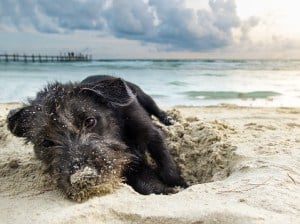Table of Contents
A day at the beach with your pup sounds like a dream come true to most pet parents. But there can be a lot to worry about: from paws that are sensitive on the hot sand to making sure your dog stays sufficiently hydrated. Here’s how to keep your pup safe and happy on your next trip to the shore.
Plan to be there 2 to 3 hours max.
Going to the beach can be exhausting for pups of any age—even if your dog loves it, a couple hours can tire him right out. Capping your time helps protect against over-exposing him to the sun. And if it’s going to be over 90°F, choose a different day altogether for the beach so your dog doesn’t get overheated.
Signs of heat stroke to look out for include rapid panting, bright red tongue, sticky saliva, vomiting, and diarrhea. If your dog is starting to look tired that’s a good sign it’s time to go, even if you’re having fun.
Bring fresh water (and not just for drinking).
Plenty of fresh water is needed to keep your pup nice and hydrated on the beach. You should offer him water at least every 20 minutes—more often if he’s being active. This can also help your pup avoid the temptation to drink salt water.
But there’s another good reason to pack the extra bottles: if your dog has been swimming in salt water, you’ll want to give them a good rinse after playing in the ocean. Once you’re at home, be sure to give your pup a bath to make sure he’s sand- and salt-free.
Beware of hot sand.
Humans know the pain of searing your bare feet on hot sand, and while we can usually fix this with a pair of flip-flops, your pup needs a different strategy.
A waxy balm can be applied to protect your dog’s paws, creating a barrier between paw pads and sand, making it safer and lots more comfortable for your pup to run around. When your pup lays down to rest, make sure he has a towel or blanket to keep his body off the sand.
Avoid a moldy leash.
Surprisingly, the everyday leash you use is probably not cut out for the beach. Most fiber materials trap water and sand that can linger and gives off that “dirty towel” smell, aka mildew.
Avoid having to toss a perfectly good leash and collar away by bringing a silicone version for beach trips. Silicone’s not only waterproof, but makes cleaning off sand and saltwater much easier.
Don’t forget sun protection!
Invest in the shade! Pick up this tented dog bed is a great way to limit sun exposure while giving him a place to rest.
However, if your dog has trouble relaxing at the beach, avoid doggie sunburn by using a pup-friendly sunscreen. This is especially important for the sensitive areas of his skin like the nose, armpits, and groin. It’s downright crucial for dogs with light-colored fur or very little fur, as they tend to be more susceptible to sunburn and melanoma.
Stay safe in the waves.
Always stay on the safe side and bring a lifejacket if you’re not 100% sure your dog will be able to handle swimming in the ocean. And don’t assume your dog can swim! Some breeds just aren’t cut out for it and won’t enjoy it, so don’t force them.
After your pup’s adventures in the sea don’t forget to check their ears. Water can get trapped in there, setting the stage for an infection, so make sure to clean your pup’s ears thoroughly after a day at the beach.
This article was adapted from the Ollie blog. Ollie delivers freshly made human-grade meals to dogs across the country, tailoring the recipes to their nutritional needs. Want to try it? Go to myollie.com to access a special 50% off discount on your first box.









